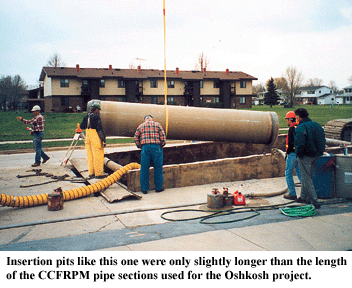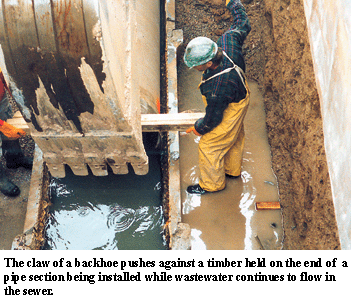Oshkosh Sewer Rehab'd with Sliplined Pipe, B'Gosh
By Ian Lisk, Editor Emeritus
The Northeast Sewer Rehabilitation project undertaken by Oshkosh was designed by the engineering firm Earth Tech. The design team, and later the construction contractor, had to deal with a set of factors that complicated the task from the beginning. The existing sewer was generally in poor condition, cover depths were as much as up to 20 ft, and there were environmental concerns, especially where the alignment was alongside the Fox River. The route crossed various underground and overhead utility lines, and went under residential front and back -yards, many buildings, and streets that were mostly concrete. Construction also had to be carried out on busy highways and city streets, and it was considered impractical to close down or reroute traffic on most of these thoroughfares.
Mixed bag of existing factors called for in-place rehab method
As a result of this mix of conditions, the engineers recommended the use of an in-place rehabilitation technique with minimal excavation such as sliplining or inversion lining. Additionally, the material of construction had to be corrosion resistant. To meet these requirements, cured-in-place pipe (CIPP), polyvinyl chloride (PVC) profile wall pipe, and CCFRPM were specified for the project.

Selected to carry out construction, the firm of Super Excavators Inc. decided to use the CCFRPM pipe manufactured by Hobas Pipe. The contractor chose this product for a number of reasons, citing among other things a lower installed cost for this project. Also mentioned in their recommendation was the smooth exterior surface and constant outside diameter of the pipe, which meant favorably lower push loads. Since the pipe was delivered in sections and used gasket-sealed low profile bell-spigot joints, the contractor could use live insertion into the operating sewer with quick assem-bly and no by-pass pumping. And as a result of the material's high stiffness it was known to be capable of withstanding elevated annular grouting pressures.
Installation phase went well, access pits eliminated
Despite continuous high flow rates in the sewer, 1279 ft of 54-in., 7550 ft of 48-in., 6057 ft of 36-in., and 26 ft of 33-in. diameter CCFRPM pipe shipped in mostly 20-ft sec-tions were installed with relative ease. The pipe material's lightweight wall and con-sistent dimensions required relatively low inser-tion force, so the sections were easily pushed using a backhoe. Average insertion rate was re-ported to be approximately 500 ft/day for all diameters, and the longest push achieved was on a 48-in. diameter drive of approximately 3000 ft in one direc-tion.

In a few locations the installation was proceeding so well that planned access pits were eliminated, which saved time and money. After the sliplining and grouting work was completed a final TV inspection of the line was performed to confirm the integrity of the rehabilitated pipeline.
This was the first time the contractor, Super Excavators, had installed this type of pipe, and the firm's personnel decided they had made a good choice of material for this project. Oskosh staff also expressed their satisfaction with the way the undertaking had gone, and Earth Tech has specified the same kind of pipe for another project in Wisconsin. An upcoming gravity sanitary sewer pipeline job in Brown County will involve about a half mile of 36-in. and 48-in. diameter pipe to be installed by micro-tunneling, and over 1.5 miles of 24-in. to 48-in. diameter which will be direct-buried.
